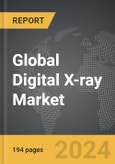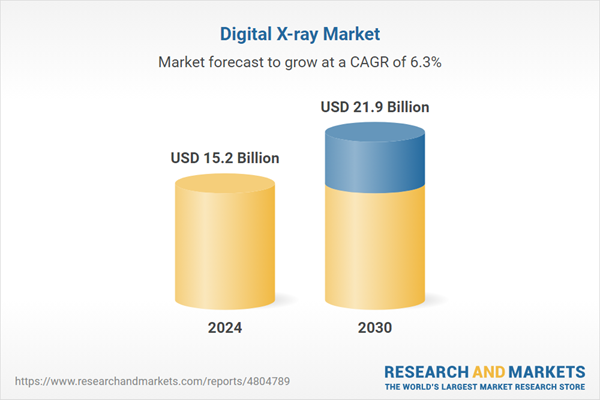The global market for Digital X-ray was estimated at US$15.2 Billion in 2024 and is projected to reach US$21.9 Billion by 2030, growing at a CAGR of 6.3% from 2024 to 2030. This comprehensive report provides an in-depth analysis of market trends, drivers, and forecasts, helping you make informed business decisions. The report includes the most recent global tariff developments and how they impact the Digital X-ray market.
Global Digital X-ray Market - Key Trends and Drivers Summarized
What Is Digital X-ray and How Does It Revolutionize Medical Imaging?
Digital X-ray is a form of X-ray imaging where sensors are used instead of traditional photographic film. This advancement significantly enhances the process of capturing and manipulating images, allowing for immediate viewing and digital storage of the data. Unlike conventional X-rays, digital versions produce clearer images and can be adjusted for contrast and brightness after they have been taken, improving diagnostic accuracy without additional exposure to radiation. This technology also reduces the time it takes to retrieve results, enabling faster diagnoses and treatment planning. Digital X-rays are increasingly being used not only in human medicine but also in dentistry, veterinary care, and industrial testing due to their efficiency and enhanced image quality.What Technological Advancements Support Digital X-ray?
The core technologies behind digital X-ray include direct flat-panel detectors and indirect flat-panel detectors, both of which convert X-rays into electrical signals without the chemical processing steps required by traditional film. Advances in detector materials have improved the sensitivity and specificity of digital X-ray systems. Moreover, the integration of software that can enhance image quality and allow for sophisticated imaging analytics like pattern recognition has been crucial. Artificial intelligence (AI) is increasingly being integrated into digital X-ray systems, providing tools that can help radiologists identify abnormalities with greater precision, thereby supporting earlier and more accurate diagnoses.How Are Digital X-rays Transforming Patient Care and Medical Workflow?
The transition to digital X-ray technology has had a profound impact on patient care by reducing the need for repeat scans and minimizing radiation exposure. The ability to immediately review images allows for quicker clinical decision-making, which is particularly critical in emergency room settings. Additionally, digital X-ray images can be easily shared with other healthcare professionals without the risk of losing information, enhancing collaboration among medical teams and improving treatment outcomes. In terms of workflow, digital systems allow for better record management and integration with Health Information Systems (HIS), reducing administrative burdens and improving overall healthcare efficiency.What Drives the Growth in the Digital X-ray Market?
The growth in the digital X-ray market is driven by several factors, including technological advancements that continue to enhance image quality and system usability, as well as a growing global health awareness that emphasizes preventive medicine and early diagnostic practices. Additionally, aging populations worldwide are contributing to an increase in musculoskeletal and cardiovascular diseases, which require radiographic imaging for diagnosis and management. The push for digitization in healthcare infrastructure, particularly in developing countries, is also propelling the adoption of digital X-ray systems. Furthermore, the ongoing improvements in AI and machine learning algorithms that can analyze X-ray images are opening new applications in predictive analytics and personalized medicine. These factors, combined with the inherent benefits of digital imaging over traditional X-ray techniques, such as reduced costs over time and enhanced patient safety through lower radiation doses, ensure robust growth and continued innovation in the digital X-ray sector.SCOPE OF STUDY:
The report analyzes the Digital X-ray market in terms of units by the following Segments, and Geographic Regions/Countries:- Segments: Technology (Direct Radiography, Computed Radiography); Portability (Fixed, Portable); System (Retrofit, New); Application (General Radiography, Dental, Mammography, Cancer, Fluoroscopy); End-Use (Hospitals, Diagnostic Centers, Dental Care Centers)
- Geographic Regions/Countries: World; United States; Canada; Japan; China; Europe (France; Germany; Italy; United Kingdom; Spain; Russia; and Rest of Europe); Asia-Pacific (Australia; India; South Korea; and Rest of Asia-Pacific); Latin America (Argentina; Brazil; Mexico; and Rest of Latin America); Middle East (Iran; Israel; Saudi Arabia; United Arab Emirates; and Rest of Middle East); and Africa.
Key Insights:
- Market Growth: Understand the significant growth trajectory of the Direct Radiography segment, which is expected to reach US$12.3 Billion by 2030 with a CAGR of a 5.2%. The Computed Radiography segment is also set to grow at 7.8% CAGR over the analysis period.
- Regional Analysis: Gain insights into the U.S. market, valued at $4.0 Billion in 2024, and China, forecasted to grow at an impressive 9.3% CAGR to reach $5.0 Billion by 2030. Discover growth trends in other key regions, including Japan, Canada, Germany, and the Asia-Pacific.
Why You Should Buy This Report:
- Detailed Market Analysis: Access a thorough analysis of the Global Digital X-ray Market, covering all major geographic regions and market segments.
- Competitive Insights: Get an overview of the competitive landscape, including the market presence of major players across different geographies.
- Future Trends and Drivers: Understand the key trends and drivers shaping the future of the Global Digital X-ray Market.
- Actionable Insights: Benefit from actionable insights that can help you identify new revenue opportunities and make strategic business decisions.
Key Questions Answered:
- How is the Global Digital X-ray Market expected to evolve by 2030?
- What are the main drivers and restraints affecting the market?
- Which market segments will grow the most over the forecast period?
- How will market shares for different regions and segments change by 2030?
- Who are the leading players in the market, and what are their prospects?
Report Features:
- Comprehensive Market Data: Independent analysis of annual sales and market forecasts in US$ Million from 2024 to 2030.
- In-Depth Regional Analysis: Detailed insights into key markets, including the U.S., China, Japan, Canada, Europe, Asia-Pacific, Latin America, Middle East, and Africa.
- Company Profiles: Coverage of players such as Canon, Inc., Carestream Health, Inc., Fujifilm Corporation, GE Healthcare, Hitachi Ltd. and more.
- Complimentary Updates: Receive free report updates for one year to keep you informed of the latest market developments.
Some of the 42 companies featured in this Digital X-ray market report include:
- Canon, Inc.
- Carestream Health, Inc.
- Fujifilm Corporation
- GE Healthcare
- Hitachi Ltd.
- Koninklijke Philips NV
- Samsung Medison Co., Ltd.
- Shimadzu Corporation
- Siemens Healthineers
This edition integrates the latest global trade and economic shifts as of June 2025 into comprehensive market analysis. Key updates include:
- Tariff and Trade Impact: Insights into global tariff negotiations across 180+ countries, with analysis of supply chain turbulence, sourcing disruptions, and geographic realignment. Special focus on 2025 as a pivotal year for trade tensions, including updated perspectives on the Trump-era tariffs.
- Adjusted Forecasts and Analytics: Revised global and regional market forecasts through 2030, incorporating tariff effects, economic uncertainty, and structural changes in globalization. Includes segmentation by product, technology, type, material, distribution channel, application, and end-use, with historical analysis since 2015.
- Strategic Market Dynamics: Evaluation of revised market prospects, regional outlooks, and key economic indicators such as population and urbanization trends.
- Innovation & Technology Trends: Latest developments in product and process innovation, emerging technologies, and key industry drivers shaping the competitive landscape.
- Competitive Intelligence: Updated global market share estimates for 2025, competitive positioning of major players (Strong/Active/Niche/Trivial), and refined focus on leading global brands and core players.
- Expert Insight & Commentary: Strategic analysis from economists, trade experts, and domain specialists to contextualize market shifts and identify emerging opportunities.
- Complimentary Update: Buyers receive a free July 2025 update with finalized tariff impacts, new trade agreement effects, revised projections, and expanded country-level coverage.
Table of Contents
I. METHODOLOGYII. EXECUTIVE SUMMARY2. FOCUS ON SELECT PLAYERSIII. MARKET ANALYSISCANADAITALYSPAINRUSSIAREST OF EUROPESOUTH KOREAREST OF ASIA-PACIFICARGENTINABRAZILMEXICOREST OF LATIN AMERICAIRANISRAELSAUDI ARABIAUNITED ARAB EMIRATESREST OF MIDDLE EASTIV. COMPETITION
1. MARKET OVERVIEW
3. MARKET TRENDS & DRIVERS
4. GLOBAL MARKET PERSPECTIVE
UNITED STATES
JAPAN
CHINA
EUROPE
FRANCE
GERMANY
UNITED KINGDOM
ASIA-PACIFIC
AUSTRALIA
INDIA
LATIN AMERICA
MIDDLE EAST
AFRICA
Companies Mentioned (Partial List)
A selection of companies mentioned in this report includes, but is not limited to:
- Canon, Inc.
- Carestream Health, Inc.
- Fujifilm Corporation
- GE Healthcare
- Hitachi Ltd.
- Koninklijke Philips NV
- Samsung Medison Co., Ltd.
- Shimadzu Corporation
- Siemens Healthineers
Table Information
| Report Attribute | Details |
|---|---|
| No. of Pages | 194 |
| Published | July 2025 |
| Forecast Period | 2024 - 2030 |
| Estimated Market Value ( USD | $ 15.2 Billion |
| Forecasted Market Value ( USD | $ 21.9 Billion |
| Compound Annual Growth Rate | 6.3% |
| Regions Covered | Global |









